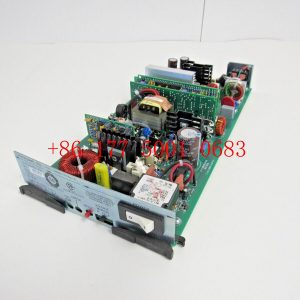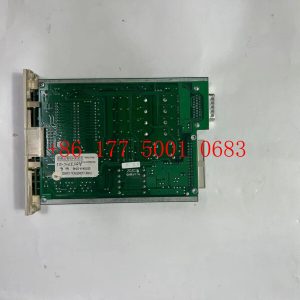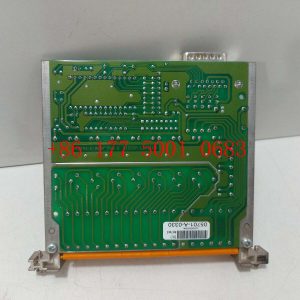Description
hardware flow control. It is an ideal choice in the field of industrial automation.
Design and implementation of variable frequency transmission system based on ABB hardware architecture
introduction
With the increasing development of transmission technology and the increasing demand for actual use, variable frequency transmission systems have been widely used.
As a Fortune 500 company in the world, ABB is a leader in the fields of power and automation technology and has strong capabilities in control
systems, high-voltage, medium-voltage and low-voltage frequency conversion technology and transmission technology. Therefore, this article mainly
relies on ABB”s control, frequency conversion and transmission technology, and uses related hardware products to design and implement the frequency conversion transmission system.
To truly design and implement a usable variable frequency drive system, the entire system must be fully equipped, conveniently operable and
compatible with a wide range of needs, so that it can be used without changing the control method and operation. According to the actual control needs,
that is, combining frequency converters with different performances and variable frequency motors with different speeds or torques to quickly build and realize a variety of control requirements.
1 System design purpose and composition
The design purpose of this system is to control ABB inverters through local and remote control methods and complete 4 independent channels
of closed-loop speed control to drive different test objects to rotate.
The entire control system consists of the following four main components: remote control computer, panel industrial computer (touch screen),
PLC and speed-regulating frequency converter. The system design block diagram is shown in Figure 1.
In order to ensure the accuracy of motor speed control, an encoder module is added. The PLC can obtain the feedback of the rotary encoder in the
frequency converter through the ProfibusDP protocol. The speed control is performed through the frequency converter for internal PID closed-loop control.
2 System hardware implementation
2.1 Control some hardware
The control part of the hardware mainly refers to the sum of hardware that supports operators to use the equipment directly or indirectly and complete
the functions of the equipment. Its main hardware includes computer control terminal, touch screen control terminal, PLC control unit, other auxiliary
circuits and measurement and control components.
2.2 Transmission hardware
The transmission hardware mainly refers to the total number of equipment that can relatively independently perform a complete transmission function.
Its main hardware includes frequency converters, variable frequency motors (configured with rotary encoders as needed) and other auxiliary circuits.
Among them, the selection of motors and frequency converters should be based on the principle of selecting the motor first and then selecting the
frequency converter. details as follows:
First, according to the tangential speed at which the object under test is to complete rotation, select the motor speed according to the following formula:
Secondly, choose based on several other important basic parameters of the motor, such as system hardness, torque, weight, etc
. This system uses ABB”s variable frequency motor.
Finally, select an appropriate frequency converter based on the motor power. In addition, the actual situation of the object being tested must also be taken
into consideration, such as whether the rotating load belongs to the heavy-load usage of the frequency converter, etc.
3Software system
System software includes three major categories in total, namely computer control software, touch screen software and PLC software. Among them, the PLC software, as the
underlying software, is responsible for the interaction with the computer control software and touch screen software on the upper side, and the interaction
with the frequency converter on the lower side. Therefore, from the architecture of the entire software system, it can be defined as a host and slave computer structure.
3.1 System development platform
The software system has two control methods: remote and local. The development platforms for the three major categories of software are Windows operating system,
LabVIEW[4] integrated development environment, CodesysV2.3, and CP400.
3.2 System software architecture
The software of the entire system is divided into three types, namely remote control software, PLC control software and local control software. Among them,
the remote control software runs under the Windows operating system and is developed under the LabVIEW integrated development environment; the PLC control software is
developed under the CodesysV2.3 programming environment; the local control software runs on the touch screen computer and is developed under the CP400 environment.
The relationship between the three software is shown in Figure 2.
https://www.xmamazon.com
https://www.xmamazon.com
https://www.plcdcs.com/
www.module-plc.com/
https://www.ymgk.com
DS200SLCCG1ACC LAN communication card
DS200UDSAG1ADE exciter board
330180-51-CN 3300 XL preprocessor sensor
Approach probe on 330103-00-03-10-02-CN
330130-040-00-05 3300 XL Extension cable
330103-00-03-10-02-CN Approach probe
330103-00-03-10-02-00 short range detector
330104-06-13-10-01-CN 3300 XL 8mm short-range probe
CDAQ-9185 785064-01 NI CompactDAQ chassis
NI-9205 779357-01 C Series voltage input module
NI-9361 783407-01 C Series counter input module
CM597-ETH 1SAP173700R0001 Communication module
330104-11-22-10-01-CN 3300 XL 8mm short-range probe
FBM218 RH922VW HART Redundant communication output interface module
PXI-6602 counter/timer equipment
330703-00-060-10-02-00 3300 XL 11mm short range probe
330703-000-070-10-01-EN 3300 XL 11mm short-range probe
PXIE-1065 PXI chassis NI
330130-080-01-00 3300 XL standard extension cable
330180-X1-00 3300 XL preprocessor sensor
330104-07-22-10-02-00 3300 XL 8mm short range probe
2711P-T9W21D8S PanelView Plus 7 Graphics terminal
MDD112C-N-030-N2L-130GA0 servo motor
C400/A8/1/1/1/00 ELAU controller
MDD112D-N-020-N2L-130GA0 servo motor
Vibro-meter VM600-ABE040 204-040-100-011 system racks
IS200EROCH1AED digital Signal processor control panel
IS200ERIOH1ACB excitation regulator I/O board
900CS10-00 Touch Screen
PLX31-EIP-MBS4 Ethernet /IP to Modbus Serial 4 ports
Honeywell 9211-ET-HN1 51154724-100 MODBUS/TCP firewall
VMIVME7750-734 VME printed circuit board
VME-7807RC-414001 single board computer
CC-TDOR01 digital output relay module
DC-TDOB01 51307186-275 Digital output module
S70602-NANANA digital servo driver
PDC235 3BHE032025R0101 Unitrol PC D235 exciter control module
3500/15-04-01 3500/15 AC power supply
3500/42-02-R0 Proximitor seismic monitor
3500/42-09-01 Proximitor earthquake monitor
3500/04-01 3500/04 Internal barrier grounding module
3500/42-09-00 Proximitor seismic monitor 3500/42M
KJ4001X1-BE1 Input/output carrier
VM600 IOCN 200-566-000-012 200-566-101-012 input/output card
3500/92-04-01-00 3500/92 Communication gateway
KJ3102X1-BA1 Security simulation input card
MVME177-003 single board computer
IC695PSA040F RX3i Power module
IS200TBCIH21CD Contact input terminal board
3500/53M-03-00 3500/53M Electronic Speed detection system
MVME162PA-252SE Embedded controller
8102-HO-IP GE 8-channel Analog Output
DEIF RMP-112D Power relay
DEIF GPU-3 generator protection unit









Reviews
There are no reviews yet.